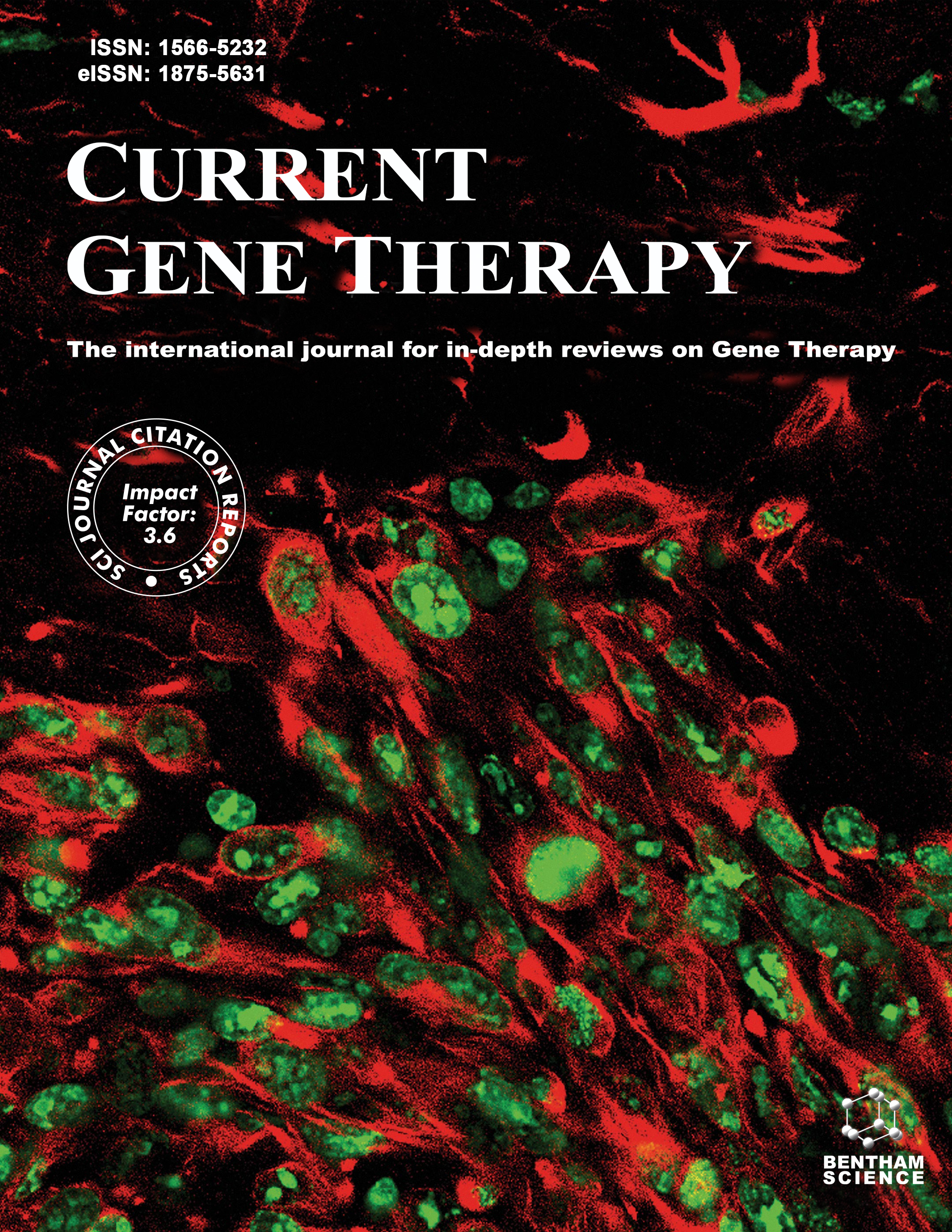- Home
- A-Z Publications
- Current Gene Therapy
- Previous Issues
- Volume 22, Issue 2, 2022
Current Gene Therapy - Volume 22, Issue 2, 2022
Volume 22, Issue 2, 2022
-
-
A Quest to the Therapeutic Arsenal: Novel Strategies to Combat Multidrug- resistant Bacteria
More LessAuthors: Priyanka Ashwath and Akhila D. SannejalThe increasing resistance of the disease-causing pathogens to antimicrobial drugs is a public health concern and a socio-economic burden. The emergence of multi-drug resistant strains has made it harder to treat and combat infectious diseases with available conventional antibiotics. There are currently few effective therapeutic regimens for the successful prevention of infections caused by drug-resistant microbes. Various Read More
-
-
-
Prospects of Non-Coding Elements in Genomic DNA Based Gene Therapy
More LessAuthors: S.P. Simna and Zongchao HanGene therapy has made significant development since the commencement of the first clinical trials a few decades ago and has remained a dynamic area of research regardless of obstacles such as immune response and insertional mutagenesis. Progression in various technologies like next-generation sequencing (NGS) and nanotechnology has established the importance of non-- coding segments of a genome, thereby Read More
-
-
-
Gene Therapy in the Anterior Eye Segment
More LessAuthors: Cynthia Amador, Ruchi Shah, Sean Ghiam, Andrei A. Kramerov and Alexander V. LjubimovThis review provides comprehensive information about the advances in gene therapy in the anterior segment of the eye, including cornea, conjunctiva, lacrimal gland, and trabecular meshwork. We discuss gene delivery systems, including viral and non-viral vectors as well as gene editing techniques, mainly CRISPR-Cas9, and epigenetic treatments, including antisense and siRNA therapeutics. We also provide a detail Read More
-
-
-
Recent Progress of Machine Learning in Gene Therapy
More LessWith new developments in biomedical technology, it is now a viable therapeutic treatment to alter genes with techniques like CRISPR. At the same time, it is increasingly cheaper to perform whole genome sequencing, resulting in rapid advancement in gene therapy and editing in precision medicine. Understanding the current industry and academic applications of gene therapy provides an important backdrop to future scie Read More
-
-
-
Predicting LncRNA-Disease Association Based on Generative Adversarial Network
More LessBackground: Increasing research reveals that long non-coding RNAs (lncRNAs) play an important role in various biological processes of human diseases. Nonetheless, only a handful of lncRNA-disease associations have been experimentally verified. The study of lncRNA-disease association prediction based on the computational model has provided a preliminary basis for biological experiments to a great degree so as to cut Read More
-
-
-
Effect of Rat Bone Marrow Derived-Mesenchymal Stem Cells on Granulocyte Differentiation of Mononuclear Cells as Preclinical Agent in Cellbased Therapy
More LessAuthors: Ezzatollah Fathi, Sheyda Azarbad, Raheleh Farahzadi, Sara Javanmardi and Ilja VietorBackground: Bone marrow mononuclear cells (BM-MNCs), as a collection of hematopoietic and mesenchymal stem cells (MSCs), are capable of producing all blood cell lineages. The use of cytokines, growth factors or cells capable of secreting these factors will help in stimulating the proliferation and differentiation of these cells into mature cell lines. On the other hand, MSCs are multipotent stromal cells that can be di Read More
-
-
-
Newly Designed Decellularized Scaffolds for Scaffold-based Gene Therapy from Elastic Cartilages via Supercritical Carbon Dioxide Fluid and Alkaline/ Protease Treatments
More LessBackground: Scaffold-based gene therapy provides a promising approach for tissue engineering, which was important and popular as it combined medical applications and engineering materials’ knowledge. Objective: The decellularization techniques were employed to remove the cellular components from porcine elastic cartilages, leaving a native decellularized Extracellular Matrix (dECM) composition and architecture int Read More
-
-
-
Human Retinal Pigment Epithelial Cells Overexpressing the Neuroprotective Proteins PEDF and GM-CSF to Treat Degeneration of the Neural Retina
More LessBackground: Non-viral transposon-mediated gene delivery can overcome viral vectors’ limitations. Transposon gene delivery offers the safe and life-long expression of genes such as Pigment Epithelium-Derived Factor (PEDF) and granulocyte-macrophage colony-stimulating factor (GM-CSF) to counteract retinal degeneration by reducing oxidative stress damage. Objective: The study aimed at using Sleeping Beauty transposon t Read More
-
Volumes & issues
-
Volume 25 (2025)
-
Volume 24 (2024)
-
Volume 23 (2023)
-
Volume 22 (2022)
-
Volume 21 (2021)
-
Volume 20 (2020)
-
Volume 19 (2019)
-
Volume 18 (2018)
-
Volume 17 (2017)
-
Volume 16 (2016)
-
Volume 15 (2015)
-
Volume 14 (2014)
-
Volume 13 (2013)
-
Volume 12 (2012)
-
Volume 11 (2011)
-
Volume 10 (2010)
-
Volume 9 (2009)
-
Volume 8 (2008)
-
Volume 7 (2007)
-
Volume 6 (2006)
-
Volume 5 (2005)
-
Volume 4 (2004)
-
Volume 3 (2003)
-
Volume 2 (2002)
-
Volume 1 (2001)
Most Read This Month
Article
content/journals/cgt
Journal
10
5
false
en

Most Cited Most Cited RSS feed
-
-
New Hope for Intervertebral Disc Degeneration: Bone Marrow Mesenchymal Stem Cells and Exosomes Derived from Bone Marrow Mesenchymal Stem Cell Transplantation
Authors: Xiao-bo Zhang, Xiang-yi Chen, Jin Qi, Hai-yu Zhou, Xiao-bing Zhao, Yi-cun Hu, Rui-hao Zhang, De-chen Yu, Xi-dan Gao, Ke-ping Wang and Lin Ma
-
- More Less

